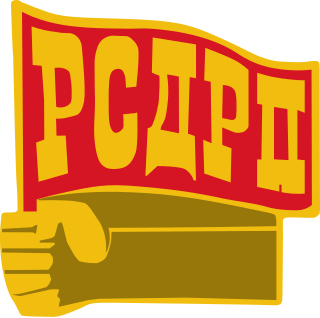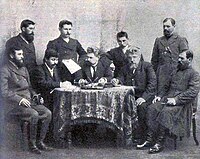
The Russian Revolution of 1905, also known as the First Russian Revolution, was a revolution in the Russian Empire that began on 22 January 1905 with a wave of civil unrest across the empire and ultimately led to the establishment of a constitutional monarchy under the Russian Constitution of 1906. The mass political and social unrest, which included included worker strikes, peasant revolts, and military mutinies, was directed against Tsar Nicholas II, the nobility, and the ruling class, who were forced to enact reforms including the State Duma and a multi-party system.

Pyotr Arkadyevich Stolypin was a Russian statesman who served as the third prime minister and the interior minister of the Russian Empire from 1906 until his assassination in 1911. Known as the greatest reformer of Russian society and economy, his reforms caused unprecedented growth of the Russian state, which was halted by his assassination.

The Constitutional Democratic Party, also called Constitutional Democrats and formally the Party of People's Freedom, was a political party in the Russian Empire that promoted Western constitutional monarchy—among other policies—and attracted a base ranging from moderate conservatives to mild socialists. Party members were called Kadets from the abbreviation K-D of the party name. Konstantin Kavelin's and Boris Chicherin's writings formed the theoretical basis of the party's platform. Historian Pavel Miliukov was the party's leader throughout its existence.
Under Tsar Nicholas II, the Russian Empire slowly industrialized while repressing opposition from the center and the far-left. During the 1890s Russia's industrial development led to a large increase in the size of the urban middle class and of the working class, which gave rise to a more dynamic political atmosphere. Because the state and foreigners owned much of Russia's industry, the Russian working class was comparatively stronger and the Russian bourgeoisie comparatively weaker than in the West.
The Union of 17 October, commonly known as the Octobrist Party, was a liberal-reformist constitutional monarchist political party in late Imperial Russia. It represented moderately right-wing, anti-revolutionary, and constitutionalist views.
The Trudoviks were a democratic socialist political party of Russia in the early 20th century.

Viktor Mikhailovich Chernov was a Russian revolutionary and one of the founders of the Russian Socialist-Revolutionary Party. He was the primary party theoretician or the 'brain' of the party, and was more of an analyst than a political leader. Following the February Revolution of 1917, Chernov was Minister for Agriculture in the Russian Provisional Government and advocating immediate land reform. Later on, he was Chairman of the Russian Constituent Assembly.

The State Duma, also known as the Imperial Duma, was the lower house of the legislature in the Russian Empire, while the upper house was the State Council. It held its meetings in the Tauride Palace in Saint Petersburg. It convened four times between 27 April 1906 and the collapse of the empire in February 1917. The first and the second dumas were more democratic and represented a greater number of national types than their successors. The third duma was dominated by gentry, landowners, and businessmen. The fourth duma held five sessions; it existed until 2 March 1917, and was formally dissolved on 6 October 1917.

Legislative elections were held in the Russian Empire from 26 March to 20 April 1906. At stake were the 497 seats in the State Duma of the Russian Empire, the legislative assembly. Election for the First State Duma, which only ran from 27 April to 8 July (O.S.) 1906, returned a significant bloc of moderate socialists and two liberal parties which demanded further reforms. For this reason, it is sometimes called the Duma of Public Anger.

The Vyborg Manifesto ; also called the Vyborg Appeal) was a proclamation signed by several Russian politicians, primarily Kadets and Trudoviks) of the dissolved First Duma on 22 July [O.S. 9 July] 1906.

The Coup of June 1907, sometimes known as Stolypin's Coup, is the name commonly given to the dissolution of the Second State Duma of the Russian Empire, the arrest of some its members and a fundamental change in the Russian electoral law by Tsar Nicholas II on 16 June [O.S. 3 June] 1907. This act is considered by many historians to mark the end of the Russian Revolution of 1905, and was the subject of intense subsequent debate as to its legality. It also created a fundamental shift in the makeup of future Dumas in the Russian Empire: whereas previous laws had given peasants and other lower-class people a larger proportion of electors to the Duma, the new law transferred this to the propertied classes, in an effort to avoid election of the large number of liberal and revolutionary deputies who had dominated the First and Second Dumas. Although it largely succeeded in this objective, it ultimately failed to preserve the Imperial system, which ceased to exist during the Russian Revolution of 1917.

Iosif Baratashvili was a Georgian politician. He belonged to the Georgian Socialist-Federalist Revolutionary Party. In the first Duma election in 1906, Baratashvili won a seat from Tiflis. He was murdered during the Great Purge.

The All Russian Constituent Assembly was a constituent assembly convened in Russia after the February Revolution of 1917. It met for 13 hours, from 4 p.m. to 5 a.m., 18–19 January [O.S. 5–6 January] 1918, whereupon it was dissolved by the Bolshevik-led All-Russian Central Executive Committee, proclaiming the Third All-Russian Congress of Soviets the new governing body of Russia.

The Party of Socialist-Revolutionaries, also known as the Socialist Revolutionary Party, was a major political party in the late Russian Empire, during both phases of the Russian Revolution, and in early Soviet Russia.

Mikhail Martynovich Alexeyenko was a lawyer in the Russian Empire. He was a professor of finance law, public figure, member of the State Duma of the Russian Empire of 3rd and 4th convocations, and rector of the Kharkov University (1890–1897).

The Russian Social Democratic Labour Party (RSDLP), also known as the Russian Social Democratic Workers' Party or as the Russian Social Democratic Party, was a socialist political party founded in 1898 in Minsk.

Vasily Onisimovich Afanasiev was a revolutionary and a propagandist of Marxism as well as a prominent activist and supporter of the Russian and international Socialist movement. He was among the active members of the RSDLP and was a Menshevik. In 1925, Anisimoff became the deputy head of the economic department of the Supreme Soviet of the National Economy of the RSFSR, managing the "Exportles" trust.

Anton Zinovevich Smagin was a farmer and merchant, a member of the Constitutional-democratic party since its Foundation to prohibit, Deputy of the State Duma of the II convocation from the Constitutional-democratic party.
An index of articles related to the Russian Revolution and the Russian Civil War period (1905–1922). It covers articles on topics, events, and persons related to the revolutionary era, from the 1905 Russian Revolution until the end of the Russian Civil War. The See also section includes other lists related to Revolutionary Russia and the Soviet Union, including an index of articles about the Soviet Union (1922–1991) which is the next article in this series, and Bibliography of the Russian Revolution and Civil War.

Ivan Vasilievich Titov was a priest, deputy of the Third and Fourth State Dumas from the Perm Governorate (1907–1917), and a candidate for delegate to the Constituent Assembly (1917).









































